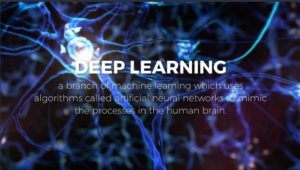 You may have seen a story or movie script that was written by a neural network before. But what is a neural network exactly? And how do you train a machine to write? As neural networks and other forms of A.I. become more popular, the demand for people who know how to code them is going to grow. If this sounds interesting to you, deep learning training may be something you want to consider.
You may have seen a story or movie script that was written by a neural network before. But what is a neural network exactly? And how do you train a machine to write? As neural networks and other forms of A.I. become more popular, the demand for people who know how to code them is going to grow. If this sounds interesting to you, deep learning training may be something you want to consider.
What Is Deep Learning?
Deep learning is essentially a way of teaching computers how to learn. Driverless cars are taught traffic laws and how to recognize pedestrians using deep learning. Voice controlled devices like Alexa also have to be taught to recognize the human voice and the words being spoken. Computers can learn how to recognize images in order to censor pornography on websites, how to recognize spam in order to move it to your junk folder, and yes, they can even learn how to recognize (and write) poetry. Large amounts of data are required in order to teach computers. Deep learning can also be used to make heavy machinery safer, as the machines can be trained to detect people that are too close to the machinery. Speech translation is another way deep learning is used. You often need 1,000+ hours of video, millions of pictures, and thousands upon thousands of words.
Why is this all important? Because it saves time and helps keep people safer. Satellites that can detect unsafe areas keep military troops safe. Deep learning applications can be used to detect cancer cells as well and help people to better fight off the disease. Driverless cars won’t get into accidents because they know to look out for stop signs, pedestrians, and other obstructions. Devices that automatically translate speech are so useful in this globalized society that we live in as well and deep learning is needed in order to make those devices in the first place.
Where Is the Training?
Deep learning isn’t something everyone knows about. Even if you are tech savvy, it’s possible that you’ve never encountered deep learning before. This is what a site like Udemy is for. They have a variety of courses on deep learning, as well as courses in Python and math that you may need to take as prerequisites prior to taking a deep learning training course. Udemy is a great way to learn any number of skills from the comfort of your own home, on your own schedule, and at a price you can afford. Udemy strives to offer as many courses to as many people as they can. They believe that lack of access shouldn’t stop anyone from learning and being able to get the skills they need to succeed in the workforce. They help train large companies, small business, non-profits, and individual people. They also perform their own research in order to understand the modern workplace and what about it can be fixed. They look at the wage gap, skills gap, workplace stress, and more topics related to how we work.
How to Teach a Machine
If you’re not sure where to get started, a good course to take is Deep Learning A-Z: Hands-On Artificial Neural Networks. In order to take this course, you should be able to do math at a high school level, at the very least. You will also need to understand the basics of Python, as that is a program you will be using in this course. This course includes over 22 hours of video lectures and 30 articles, as well as templates. You will have the opportunity to work with some open-source deep learning libraries, including TensorFlow, Pytorch, Theano, and Keras. You’ll also use Scikit-Learn for a few different tasks. In addition to using Python, you’ll use Numpy, Matplotlib, and Pandas to help with computations, charts, and importing data. If you’re not sure what those programs are or how to use them, don’t worry! You will learn. Throughout the course, you will use real-world case studies as the basis for your neural network projects. You’ll create a neural network that can find certain objects within images, one that can predict stock prices, one that can make Netflix recommendations, and more! By the end of the class, you will have learned a number of different programs and gained tools for future projects. Plus, you’ll have some great neural networks you can keep using as you go forward in your learning.
If you are interested in machine learning as well as deep learning, Machine Learning, Data Science, and Deep Learning with Python with Frank Kane is the course for you. This course requires some scripting and programming experience as well as high school level math skills. It has 12 hours of video and 3 articles. Many of the lectures have Python code examples you can use to help you throughout the course. This course is designed to be easy to understand so don’t worry about not knowing a lot of technical jargon, any vocabulary specific to this field will be explained in the course. You will start with a quick lesson on Python and then move on to topics like data mining, predictive models, experimental design, and how to use real-world data. You will also get an introduction to Apache Spark, a computing framework, and MLLib, which is Spark’s machine learning library. When you go on to work on deep learning, you’ll use TensorFlow and Keras. You will learn both the theory behind machine learning and deep learning, in addition to working on hands-on projects. You’ll even learn the ethics involved with deep learning. At the end of the course, you’ll complete a final project in order to show off all the skills you have learned.
Want to take a deep learning class without all the prerequisites? The Data Science Course 2019: Data Science Bootcamp is the course for you. The only requirements are that you have access to Microsoft Excel and that you can download Anaconda. No prior experience with programs like Python needed as you will learn the basics in this course. You don’t need to worry if your math skills aren’t up to snuff either, this course goes over mathematics and statistics. You will watch over 20 hours of video lectures and have access to 70 articles. You’ll use the data libraries like TensorFlow and Scikit-Learn, just like in the other available courses. What is different is that you’ll also learn how to use Tableau to help deal with data. This course will teach you how to create algorithms, perform linear regressions, and how to do factor analysis. This course is designed so that you are taught deep learning from the ground up, including all the math and programming skills not taught in other courses. By the end of the class, you’ll definitely be on your way to becoming a data scientist.
 A more advanced course is Data Science: Deep Learning in Python. This requires prior knowledge of linear algebra, calculus, Python, probability, and coding in Numpy. You will need to install both Python and Numpy prior to starting the course as well. This course contains 9.5 hours of video lectures. In it, you will learn all about how a neural network is built and how to identify the different types of neural networks as well as what they are used for. You will create a neural network from the ground up throughout the course of the class so you’ll get to put all the theory and knowledge to use in a hands-on way. By the end of the course, you’ll know how to put all the knowledge you already had to use in creating neural networks.
A more advanced course is Data Science: Deep Learning in Python. This requires prior knowledge of linear algebra, calculus, Python, probability, and coding in Numpy. You will need to install both Python and Numpy prior to starting the course as well. This course contains 9.5 hours of video lectures. In it, you will learn all about how a neural network is built and how to identify the different types of neural networks as well as what they are used for. You will create a neural network from the ground up throughout the course of the class so you’ll get to put all the theory and knowledge to use in a hands-on way. By the end of the course, you’ll know how to put all the knowledge you already had to use in creating neural networks.
Another way to use deep learning is for Natural Language Processing. You can learn all about NLP in Natural Language Processing with Deep Learning in Python. You will already need prior experience with coding a neural network in order to successfully complete this course, in addition to having most of the programs and data libraries that are used in the other available deep learning courses. Knowledge of Python, Numpy, probability, calculus, and linear algebra will also help greatly with this class. You will learn how to solve NLP problems such as part-of-speech tagging and how to use methods like bag-of-words in order to have your program detect spam and even writing poetry! The course has 13 hours of video and by the end, you will be able to use neural networks in order to solve NLP problems and you’ll have a deeper understanding of deep learning.
Neurons and Neural Networks
Deep learning training may require a lot of prior knowledge but it is definitely worth it! Not only do you get to learn all about an exciting new concept, but you get to learn a variety of different programs and gain access to open-source data libraries. Deep learning is only going to become more popular and the demand for people who can code neural networks is going to increase. Why not join the ranks of data scientists helping to teach machines?